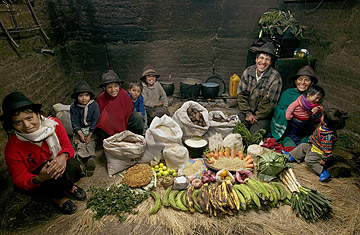
Ecuador
The Ayme family of Tingo
Food Expenditure for one week: $31.55
Cooking Method: Wood fire
(2 of 3)
Such longing for what was may be only natural, but before we get too misty over the way we used to eat, it's important to remember that the first purpose of food is to keep us alive—something that used to be a lot harder than it is today. For thousands of years, humans were chiefly agrarian, which meant that you ate only what you could grow or slaughter yourself or trade for locally. Geography was culinary destiny.
Africa, which strains under so much political and economic hardship, is the place where this ancient reality is in greatest evidence today. Throughout much of the continent, people remain tied to the land and therefore dependent on it. Most meals are keyed around a single calorie-rich starch—in East Africa, it's often cornmeal or flour made into a stiff porridge—with extra food added if available. Meat remains a rare indulgence, something reserved for holidays and feasts. Even relatively well-fed populations like the Iraqw of Tanzania, who typically eat three full meals a day, must brace for periods when that is impossible. "In times of food insecurity—right before a harvest—or in a bad year, they will reduce this to two or one meals," says Crystal Patil, an anthropologist at the University of Illinois in Chicago. "If there are several bad years in a row, it can be devastating." Often, the only sure foods are largely useless ones, those sloshing over from the well-fed world outside. "I've never seen a village where you couldn't find a Coke," says Chaiken.
All human cultures may have started out with this kind of day-to-day, harvest-to-harvest existence, but the better environmental hand that people of other regions drew—richer soil, fewer droughts, milder temperatures—allowed them to tame their land, meaning that the food they ate and the lives they lived could evolve together. In agrarian, preindustrial Europe, for example, "you'd want to wake up early, start working with the sunrise, have a break to have the largest meal, and then you'd go back to work," says Ken Albala, a professor of history at the University of the Pacific. "Later, at 5 or 6, you'd have a smaller supper."
This comfortable cycle, in which the rhythms of the day helped shape the rhythms of the meals, gave rise to the custom of the large midday meal, eaten with the extended family, that is still observed in pockets of Southern and Western Europe. "Meals are the foundation of the family," says Carole Counihan, an anthropologist at Millersville University in Pennsylvania and author of Around the Tuscan Table, "so there was a very important interconnection between eating together" and cementing family ties.
Since industrialization, maintaining such a slow cultural metabolism has been much harder, with the long midday meal shriveling to whatever could be stuffed into a lunch bucket or bought at a food stand. Certainly, there were benefits. Modern techniques for producing and shipping food led to greater variety and quantity, including a tremendous increase in the amount of animal protein and dairy products available, making us more robust than our ancestors. In contemporary China, where tens of millions were starving less than 50 years ago, meat has become far more common, and Chinese youth are on average 2.4 in. taller than they were just three decades ago. "China has gone from a sparse diet to a point where it's got almost too much," says James Watson, professor of Chinese society and anthropology at Harvard University. "As a nutritionist, you have to be outraged. As a historian, you have to consider it one of the biggest success stories on the planet."